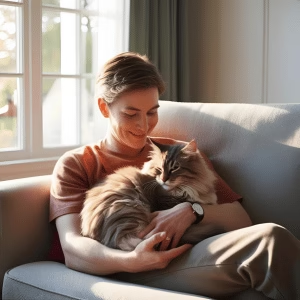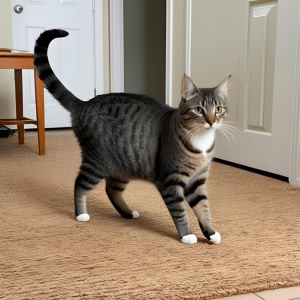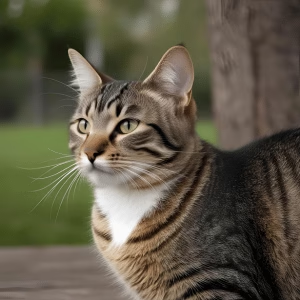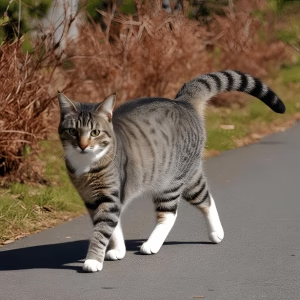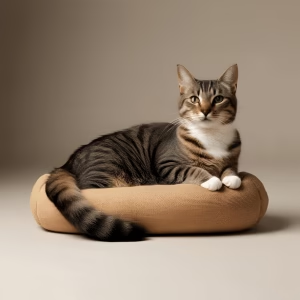Real Talk: Ever caught your cat staring at you with those mysterious eyes and wondered what the heck is going on in their head?
Here’s the truth most people don’t realize: your cat is communicating with you constantly. Every tail swish, every ear rotation, every slow blink, it’s all deliberate. You’re just not fluent in their language yet.
But you’re about to be.
I’ve spent countless hours observing cats, and I’m constantly amazed by how much they express without making a sound. Their communication system is elegant, nuanced, and way more sophisticated than most people give them credit for.
By the time you finish this guide, you’ll view your furry friend’s movements in an entirely new light. You’ll catch the subtle signals you’ve been missing all along, and your relationship with your cat will fundamentally change.
Why Understanding Your Cat Matters (More Than You Think)
Cats aren’t known for their straightforward communication style. Unlike dogs who practically spell out their needs, cats operate on a more subtle frequency. Their communication style reflects thousands of years of evolution, they needed a complex system of signals that could convey messages without attracting unwanted attention from predators or prey.
Here’s what most people miss: when you learn to read your cat’s body language, you’re not just gaining a cool skill. You’re actually reducing household stress, improving your cat’s welfare, and building a bond that’ll blow your mind.
Think about it:
- Stress reduction: You’ll catch early signs of anxiety or discomfort before your cat escalates into destructive behavior or aggression
- Better health outcomes: Cats can’t tell us when they’re in pain, but their body language will. Recognizing these signals leads to earlier vet intervention
- Deeper connection: There’s something profoundly satisfying about truly understanding your cat’s needs and responding appropriately. This mutual understanding builds trust in ways simple cohabitation never could
Want to dig deeper into specific topics? We have a comprehensive guide on cat tail meanings.
Tail Talk: Your Cat’s Mood Barometer
Want to start understanding cat communication? Begin with the tail. It’s essentially a mood detector in motion, constantly broadcasting your cat’s emotional state through position, movement, and even fur appearance.
Tail Language Quick Reference
| Tail Position | What It Means | Your Cat Is Feeling… |
|---|---|---|
| Straight up with slight curve | Confident, greeting behavior, friendly | Happy, secure, loving |
| Question mark (hooked tip) | Maximum contentment and affection | Maximum happiness in your presence |
| Low or tucked | Fear, submission, or anxiety | Scared, insecure, stressed |
| Slow, gentle swish | Focused attention or mild interest | Concentrating, curious |
| Rapid thrashing | Building agitation or overstimulation | Irritated, about to snap, frustrated |
| Puffed up/bottled | Defensive posture during threat | Scared, defensive, ready to fight |
Pro Tip: The distinction between a relaxed low tail and a fearful tucked tail is subtle. Look for tension in the tail itself. A relaxed tail maintains a natural curve, while a fearful tail appears stiff and tightly held.
Understanding Tail Twitching and Wagging
Unlike dogs, whose tail wagging signals happiness, a cat’s wagging tail usually indicates emotional conflict or building agitation. This is where context becomes crucial.
Slow, gentle swishing: Your cat is concentrating on something interesting, a toy, potential prey, or that bird outside. This represents controlled excitement, not aggression.
Increasing speed and intensity: As swishing increases, so does emotional arousal. Could be positive (excitement during play) or negative (growing irritation). Look at the rest of their body for clues.
Rapid thrashing: This is a warning sign. Your cat is overstimulated or annoyed. You’ll see this during petting sessions that went on too long or when your cat’s watching something frustrating (like that bird they can’t reach). Back off now or prepare for the swat.
Ear Language: Tiny Movements, Big Meanings
Cat ears are remarkably expressive communication tools. These mobile sound locators don’t just help cats hunt, they’re broadcasting emotional state with remarkable precision.
The Ear Position Chart
| Ear Position | Signal | Emotional State |
|---|---|---|
| Pointed forward, natural position | Alert, interested, engaged | Comfortable, curious, safe |
| Slightly forward and rotated outward | “Airplane ears of happiness” | Extremely happy, playful |
| Flattened backward | Defensive posture warning | Distressed, fearful, or aggressive |
| One backward, one forward | Split awareness, divided attention | Cautious monitoring, uncertain |
| Rapid twitching | Processing multiple stimuli | Nervous, uncertain, assessing threat |
When ears flatten completely against the head, pressed tightly and held defensively, your cat feels threatened. This is often accompanied by an arched back, puffed tail, hissing, or growling. When you see this constellation of signals, it’s not the time for cuddles, give your cat space and identify what’s causing the distress.
The Windows to the Soul: What Cat Eyes Reveal
A cat’s eyes communicate volumes. From pupil size to blink rate, these expressive organs offer perhaps the most direct insight into your cat’s mind.
Pupil Dilation: Beyond Just Light Response
While pupils naturally react to light, emotional states can override these automatic responses.
Dilated pupils in normal lighting: Excitement, fear, or aggression (depends on context). During play or hunting, dilated pupils help cats take in more visual information and prepare for action. Conversely, extremely constricted pupils in normal lighting might indicate agitation or overstimulation.
The Slow Blink: Your Cat’s Secret “I Love You”
Perhaps the most endearing feline eye signal is the slow blink, sometimes called a “cat kiss.” When your cat looks at you and deliberately closes their eyes slowly, they’re displaying profound trust. In cat language, closing their eyes in your presence means they feel secure enough to temporarily surrender their vigilance.
You can return this gesture by slowly blinking back. Many cats will respond positively, sometimes approaching for affection afterward. Research has confirmed this slow-blinking behavior facilitates positive emotional communication between cats and humans. It’s essentially a universal sign of feline affection.
Eye Contact: When It’s Affection vs. Confrontation
Direct eye contact has different meanings depending on delivery. A soft gaze with relaxed eyes signals affection and trust. An unblinking stare can be threatening or challenging.
In feline social interactions, the cat who breaks eye contact first is typically acknowledging the other’s higher status. When your cat holds your gaze steadily without aggression signals, they’re displaying remarkable trust.
Face Expressions: Whiskers, Mouth Position, and the Flehmen Response
While cats don’t have the facial mobility of humans, their faces communicate important information through subtle changes and specific expressions.
Whisker Positions: The Overlooked Indicators
Whiskers are exquisitely sensitive tactile organs that also serve as emotional barometers. Forward-pointing, slightly spread whiskers indicate curiosity and positive engagement. This is your cat’s “happy face”, relaxed but attentive.
When whiskers are pulled back against the cheeks, your cat is feeling fearful or defensive. This position keeps these sensitive organs protected and out of the way in case of conflict.
During intense focus, like when hunting or playing, whiskers point forward and bunch slightly, helping cats gauge distances precisely. This concentrated whisker position often precedes pouncing or other high-energy movements.
Mouth Movements: From Contentment to Aggression
A slightly open mouth with relaxed jaw muscles often indicates contentment, particularly when accompanied by purring. Some cats even sleep with their mouths slightly ajar when deeply relaxed.
A tense, closed mouth with tight jaw muscles suggests anxiety or discomfort, while a wide-open mouth displaying teeth clearly communicates aggression or extreme fear. Context helps distinguish between these emotional states.
The Flehmen Response: That Weird Open-Mouth Expression
You’ve probably seen your cat make that bizarre open-mouthed expression, sometimes with the upper lip curled back. This is the flehmen response, and it’s not a sign of aggression or illness.
Your cat is actually drawing scents toward the vomeronasal organ (Jacobson’s organ) in the roof of their mouth, which helps them process and analyze complex odors. You’ll often see this after cats sniff something particularly interesting, novel, or sexually relevant (like another cat’s scent marking or a special toy).
What it means: “This is interesting, let me investigate this smell more carefully.” It’s essentially a sign of curiosity and deep olfactory investigation, not a threat or health concern.
Feline Vocalizations: The Sound Side of Cat Communication
While body language is crucial, cats also communicate through a sophisticated system of vocalizations that work alongside physical signals.
Understanding Cat Meows
Here’s something most people don’t realize: adult cats almost never meow at each other. This vocalization evolved specifically for human-cat communication. Kittens meow to their mothers, but adult cats adapted this sound to communicate with humans, essentially treating us as surrogate parents.
Short, high-pitched meows: Typically greetings or requests for attention. Your cat is saying “hi” or “I want something.”
Long, low-pitched meows: Usually indicate dissatisfaction or demands. Think of it as your cat complaining or insisting you pay attention.
Multiple meows in a row: Excitement or enthusiasm. Your cat is amped up about something positive.
Silent meow (mouth moving, no sound): Often a sign of trust and affection. Your cat is “talking” to you but has nothing urgent to say.
Chirps, Trills, and Positive Vocalizations
Chirps and trills, those delightful rolling “r” sounds, are typically positive communications. Mother cats use these sounds to call their kittens, and many domestic cats use them as friendly greetings or to get their humans to follow them somewhere (like “come here, I want to show you something”).
A trilling cat approaching you is essentially saying “hello, friend.” These vocalizations paired with an upright tail and forward ears are among the most positive signals your cat can send.
Warning Vocalizations: Hissing and Growling
Hissing and growling are unmistakable warning signals that should always be taken seriously. These sounds indicate your cat feels threatened and is prepared to defend themselves if necessary.
Hissing: Often the first warning. Your cat is saying “back away” or “stay out of my space.”
Growling: A deeper, more serious warning. Your cat is escalating from the hissing stage and may bite if the threat doesn’t retreat.
Yowling: A long, drawn-out vocalization typically indicating distress, territorial disputes, or in unsprayed females, mating behavior. This can be heard from remarkable distances.
Chattering and Clicking Sounds
The chattering or chittering sound cats make when watching prey through windows reflects hunting excitement and possibly frustration at not being able to reach their target. Some behaviorists believe this is a displacement behavior, where your cat is mimicking the kill bite they’d use on prey.
What it means: “I see prey, I want it, I’m frustrated I can’t reach it.” This is a sign of intense focus and hunting instinct, not aggression toward you.
Understanding Slow Motion Behavior: Speed as an Emotional Indicator
One of the most underrated aspects of cat body language is movement speed. How fast or slow your cat moves tells you as much about their emotional state as any other signal.
The Relaxation-Speed Connection
Slow, deliberate movements: These signal complete relaxation and comfort. A cat moving in slow motion, taking their time grooming or walking across a room, is telling you they feel absolutely safe in their environment.
Think about it: a predator who feels threatened moves quickly and efficiently. Slow movement means there’s no threat perceived. When your cat leisurely stretches, slowly walks to their water bowl, or takes their time grooming their fur, they’re essentially saying “I’m home, everything is good.”
Stretched-out, deliberate pacing: This is different from anxious pacing. A cat in slow motion, with loose limbs and no tension, is a supremely confident and relaxed cat. Compare this to the quick, jerky movements of an anxious cat, and you’ll immediately see the difference.
Quick, Efficient Movements Signal Concern
Rapid movements: When your cat suddenly speeds up, starts quick-stepping, or moves with visible tension, they’re assessing a potential threat or have detected something requiring attention.
Darting or running: This could mean several things depending on context. Playful running is fast but bouncy and exaggerated. Fearful running is direct and purposeful, usually toward a safe hiding spot.
Freeze (complete stillness): This is neither relaxed nor moving. A completely still cat is in assessment mode, processing a potential threat and deciding whether to flee, fight, or wait. This freeze response is a classic defensive strategy.
Slow Motion Grooming: The Ultimate Comfort Signal
Watch how your cat grooms when they’re truly relaxed. Slow, deliberate licks, taking their time, not rushing. This is a cat in complete comfort mode. Contrast this with quick, frantic grooming (which might indicate stress or anxiety).
Context matters: A cat quickly bathing specific areas might be addressing discomfort or stress, while a cat slowly grooming their entire body in a relaxed position is simply enjoying maintenance and comfort.
Multi-Cat Dynamics: Reading Escalating Conflict Between Cats
In multi-cat households, the game changes dramatically. Understanding how cats communicate conflict with each other is crucial for preventing serious fights.
The Stages of Cat-to-Cat Escalation
Stage 1: Visual Intimidation (No Contact)
What you’ll see: Cats staring at each other intently. One or both cats have dilated pupils, forward-focused attention, ears in normal or slightly rotated positions. They’re stationary, watching.
What it means: “I see you, I’m assessing you.” This is the beginning of a potential conflict but can resolve peacefully.
What to do: Redirect attention with toys or treats. Break the stare. This is still preventable.
Stage 2: Posturing and Indirect Displays
What you’ll see: One or both cats begin raising their body slightly, ears rotating back (not fully flattened yet), tail either raised or swishing slowly. They may circle each other at a distance, neither advancing nor retreating. Body appears slightly tense but not fully defensive.
What it means: “I’m not backing down, I’m ready if you are.” This is escalation but still manageable.
What to do: Intervene now. Create distance between the cats. They’re deciding if they’ll actually fight.
Stage 3: Direct Approach and Stiff-Legged Walking
What you’ll see: One or both cats begin moving toward each other with stiff, unnatural leg movements. Bodies are tense, ears rotated back but not fully flattened yet. Tail may be puffed or swishing rapidly. Direct eye contact intensifies.
What it means: “I’m moving this forward.” They’re no longer just assessing, they’re approaching with intent.
What to do: Separate immediately. Use a barrier, distraction, or physically intervene if safe to do so. This is the point of no return heading fast.
Stage 4: Hissing, Growling, and Defensive Posturing
What you’ll see: One or both cats display full defensive postures (arched back, puffed tail, body sideways to appear larger). Ears are fully flattened against the head. Hissing and growling sounds are present. Neither cat is retreating.
What it means: “I will fight you if you don’t back down.” This is serious conflict about to happen.
What to do: Separate immediately by any means necessary. Don’t try to pick up either cat. Use a broom, obstacle, loud noise, or water spray to interrupt.
Stage 5: Contact and Fighting
What you’ll see: Wrestling, biting, hissing, fur flying. Both cats are engaged in physical contact.
What it means: Full conflict is happening now.
What to do: Only intervene if you can do so safely (risk of bites to yourself). Throw a blanket over them to disorient, use loud noise, or spray water. Never put your hands directly between fighting cats.
De-escalation Signals: When Cats Are Making Peace
Breaking eye contact: The cat who looks away first is typically de-escalating. This is a good sign.
Slow head turns away: A cat turning their head slowly away from another cat (especially if accompanied by blinking) is saying “I’m not a threat, let’s end this.”
Sitting down or lying down: When a tense cat suddenly sits or lies down, they’re often signaling they’re no longer in confrontation mode.
Moving away (slow retreat): A cat slowly walking away from another cat is typically safe de-escalation. Compare this to a rapid, panicked retreat, which suggests fear rather than peace.
Mutual grooming or nose touching: If both cats suddenly approach calmly and sniff each other’s noses or begin grooming, they’ve made peace. These are positive reconciliation signals.
Mood Indicator Chart: Reading Your Cat’s Emotional State
Here’s where everything comes together. Use this chart to quickly assess your cat’s current mood by observing multiple body language signals simultaneously:
😻 HAPPY & CONTENT
- Tail: Upright, slight curve at tip
- Ears: Forward, relaxed
- Eyes: Soft, slow blinks
- Body: Relaxed, loose, slow movements
- Mouth: Slightly open or neutral
- Whiskers: Forward-pointing
- Vocalizations: Soft purring, occasional trills
😼 PLAYFUL & EXCITED
- Tail: Raised, swishing
- Ears: Forward or “airplane” position
- Eyes: Dilated, focused
- Body: Crouched or bouncy, quick movements
- Mouth: Open in silent meow
- Whiskers: Forward, bunched
- Vocalizations: Chirps, excited meows
😾 STRESSED & FEARFUL
- Tail: Low, tucked, or puffed
- Ears: Flattened, rotated backward
- Eyes: Wide, dilated, focused on threat
- Body: Crouched, frozen, or retreating, stiff movements
- Mouth: Closed, tense, or hissing
- Whiskers: Pulled back against cheeks
- Vocalizations: Hissing, growling, yowling
😾 IRRITATED & OVERSTIMULATED
- Tail: Rapid thrashing
- Ears: Slightly back, twitching
- Eyes: Pinpoint pupils, intense stare
- Body: Tense, muscles coiled, quick jerky movements
- Mouth: Closed, tight jaw
- Whiskers: Neutral to pulled back
- Vocalizations: Low growls or sudden silence
⚠️ Important: The best way to read your cat is to observe multiple signals together, not just one. A tail swish combined with relaxed ears and soft eyes is very different from a tail swish with flattened ears and dilated pupils.
Full-Body Postures: Reading Your Cat From Head to Tail
While individual body parts communicate specific messages, the overall posture of your cat provides the most comprehensive insight into their emotional state.
The Confident Cat
A confident, comfortable cat carries themselves with a relaxed posture, body neither crouched nor overly stretched, tail held in a natural position (often slightly raised), ears forward, and eyes soft. Their movements are fluid and deliberate rather than jerky or hesitant. They move through their environment in slow, deliberate motions, taking their time.
During relaxed social interactions, confident cats might roll onto their side or back, exposing their vulnerable belly. This isn’t necessarily an invitation for belly rubs but rather a display of trust and security in their environment.
The Defensive Posture
The classic “Halloween cat” pose, arched back, puffed tail, fur standing on end, is a defensive posture designed to make the cat appear larger and more intimidating. This dramatic display is a warning that your cat feels cornered or threatened.
Some cats respond by making themselves smaller, crouching low with tail tucked and ears flattened. This defensive posture minimizes their profile and prepares them for quick escape.
The freeze response is another common defensive strategy. A cat who suddenly becomes completely still is assessing a potential threat and deciding whether to flee, fight, or remain hidden.
Relaxation Signals
Few sights are more satisfying than a completely relaxed cat. The “loaf” position, sitting with paws tucked underneath, indicates your cat feels secure enough to partially conceal their limbs.
The side-sleeping position with exposed belly and extended limbs represents maximum relaxation. Cats only sleep this way when they feel absolutely secure, as it leaves them temporarily vulnerable.
The key indicator of true relaxation is movement speed and quality. Slow-motion movements, like leisurely stretching or casual grooming, signal relaxation. When cats feel threatened, their movements become quick and efficient, the luxury of slow movement is reserved for safe environments.
Touch Receptivity: When Your Cat Wants Affection (And When They Don’t)
Cats have complex preferences about physical contact that vary based on mood, context, and even time of day.
Invitation Signals: When Your Cat Wants Cuddles
The head-butt or “bunting” behavior, when cats push their heads against you, is both a greeting and an invitation for contact. This deposits facial pheromones that mark you as safe and familiar.
Leaning against your leg or hand is another subtle request. Many cats prefer this passive form of touch, where they control the pressure and duration by moving their bodies against yours.
The slow approach with tail up and slight curve, often accompanied by purring or trilling, is a clear social invitation. This is your cat actively seeking interaction and likely welcomes gentle petting.
Warning Signs: When Touch Is Unwelcome
Skin rippling or twitching: During petting, this often precedes over-stimulation. Your cat is beginning to find the contact uncomfortable and may soon react more dramatically if it continues.
Tail thumping: During petting, this is a clear “stop now” signal. This indicates your cat has reached their tolerance threshold.
Dilated pupils, flattened ears, or tensing: Early warning signs that your cat is becoming uncomfortable. Respecting these signals prevents escalation to scratching or biting.
✓ Pro Move: Respect your cat’s boundaries. When they signal they’re done with petting, immediately stop. This builds trust and teaches them that their communication works with you.
Context Examples: Real-World Scenarios Decoded
Let’s apply all this knowledge to actual situations you’ll encounter:
Scenario 1: Your Cat Greets You at the Door
The signals: Tail straight up with slight curve, ears forward, slow blink, head-butt against your leg, soft trilling sound.
Translation: “I’ve missed you, you’re family, I trust you completely.” This is the cat equivalent of a warm welcome home.
Scenario 2: Your Cat Approaches During a Petting Session, Then Suddenly Attacks
The progression: Started with soft purring and head-butts (good), then you continued petting for several more minutes. You notice skin rippling on their back, rapid tail swishing, ears slightly rotated back, eyes beginning to dilate.
Translation: “I was enjoying this, but I’m reaching my limit. You had warning signals, now I’m attacking because you didn’t stop.” This is your cat communicating that their tolerance threshold was reached.
What to do next time: When you notice skin rippling or rapid tail swishing, it’s time to stop petting immediately. End on a positive note.
Scenario 3: Your Two Cats Have Been Staring at Each Other for 30 Seconds
The signals: Both cats motionless, intense eye contact, ears in normal position (not yet flattened), tails raised or neutral.
Translation: “I see you, and I’m not sure about this.” This is the early stage of potential conflict.
What to do: Intervene now with toys, treats, or redirection. Break the stare before it escalates. This is the easiest point to prevent a fight.
Scenario 4: New Kitten in the House, Your Adult Cat’s Response
The signals: Flattened ears, slow tail swish (not rapid), narrowed eyes, staring intently at the kitten.
Translation: “This new thing is interesting but potentially threatening. I’m not happy about it.” This is neither full aggression nor acceptance, just assessment.
What to do: Don’t force interaction. Give your cat space and time. Most cats gradually accept newcomers, but they need time to assess the situation on their terms.
Scenario 5: Your Cat Hides Under the Bed After a Vet Visit
The signals: Ears flattened, tail tucked tightly, eyes dilated and wild-looking, refuses to come out.
Translation: “That was terrifying and I don’t feel safe yet.” Your cat experienced stress and is regulating by hiding in a safe place.
What to do: Leave them alone. Don’t force them out. Provide water and a litter box nearby. Let them emerge when they’re ready. This usually takes a few hours to a day.
Common Misinterpretations: Where We Get It Wrong
Even experienced cat owners misread feline signals. Here are the most common mistakes:
The Exposed Belly Fallacy
A dog’s exposed belly is an invitation for belly rubs. A cat’s exposed belly is usually a sign of trust and comfort, not an invitation for touching. Many cats react defensively when their bellies are touched, despite voluntarily exposing them.
Translation error: “My cat wants belly rubs because they’re showing me their belly.”
Reality: “My cat trusts me enough to expose a vulnerable area, but that doesn’t mean they want it touched.”
The Tail Wagging Confusion
Dog’s wagging tail, happiness. Cat’s wagging tail, agitation or conflict. This fundamental difference leads to frequent misunderstandings in multi-pet households where owners assume the cat is happy when they’re actually building toward aggression.
Projection and Misinterpretation
Myth: “My cat is spiteful and knocked my cup off the shelf to punish me.”
Reality: Cats don’t conceptualize revenge. They knocked the cup because it was interesting, it moved, or they were seeking attention (even negative attention). Or they just miscalculated.
Myth: “My cat purrs because they’re always happy.”
Reality: Cats purr to self-soothe during stress or pain as well. Look at context. Purring during a vet exam isn’t happiness, it’s self-soothing.
Key insight: Cats don’t operate on human emotion logic. They respond to immediate needs, environmental factors, and learned associations. Understanding this shifts your entire perspective on feline behavior.
Building Trust Through Communication
Understanding your cat’s communication is only valuable if you use that knowledge to improve your relationship.
The Foundation: Responsiveness
When your cat signals discomfort during handling and you immediately respect that boundary, you’re teaching them that communicating with you works. This builds profound trust.
Creating predictable routines helps cats feel secure. When cats can anticipate feeding times, play sessions, and quiet periods, they experience less stress and communicate more clearly.
Environmental Enrichment
Vertical space (cat trees, shelves), hiding spots, and observation perches allow cats to communicate their preferences through chosen locations. Regular interactive play sessions stimulate positive communication patterns.
FAQs: Your Cat Communication Questions Answered
Q: Why does my cat stare at me without blinking?
Unblinking staring can have multiple meanings depending on context. If your cat appears relaxed with normal-sized pupils, they’re showing interest or affection. A hard stare with dilated pupils and tense body posture could indicate fear or aggression. The key difference is in accompanying body language, look for relaxed versus tense muscles, ear position, and tail movement to determine whether the stare is friendly or confrontational.
Q: My cat suddenly runs around wildly for no reason, what is this communicating?
These sudden bursts of activity, often called “zoomies” or FRAPs (Frenetic Random Activity Periods), typically indicate excess energy needing release. Indoor cats especially may accumulate energy during inactivity. This usually communicates healthy exuberance rather than distress, particularly when it occurs at dawn, dusk, or after using the litter box. However, if these episodes seem triggered by discomfort (like after grooming a particular area), it might warrant a veterinary check.
Q: How can I tell if my cat’s purring indicates pain rather than pleasure?
Context is crucial for interpreting purring. Pain-related purring often occurs in situations where pleasure is unlikely, like during veterinary examinations or when your cat is isolating themselves. Look for accompanying signs of discomfort: hunched posture, glazed expression, reluctance to move, or unusual stillness. Pain purring tends to be more intermittent and may sound slightly different from contentment purring. When in doubt, consult your veterinarian.
Q: Why does my cat knead me with their paws?
Kneading, the rhythmic pushing of paws against soft surfaces, is behavior that begins in kittenhood to stimulate milk flow from the mother. When adult cats knead humans, they’re displaying comfort, contentment, and a return to kittenhood feelings of security. It’s essentially a compliment, indicating your cat associates you with maternal comfort and safety. Some cats also knead before settling down to sleep, possibly an evolutionary behavior to create a comfortable resting spot.
Q: My cat brings me “gifts” like toys or sometimes dead animals, what is this communicating?
This behavior has multiple interpretations. From an evolutionary perspective, mother cats teach hunting to kittens by bringing them prey, so your cat may be “teaching” you to hunt. Alternatively, they may be contributing to the “colony” by sharing resources. Some behaviorists suggest it’s simply your cat bringing their “kill” to a safe place to enjoy. Regardless of specific motivation, this behavior indicates your cat considers you part of their social group and trusts you enough to share their prized possessions.
Q: What does it mean when my cat “makes biscuits” with their paws?
This kneading motion mimics the natural behavior of kittens stimulating their mother’s milk production. In adult cats, it indicates extreme comfort and contentment. If your cat is making biscuits while sitting on you and purring, they’re essentially saying “you’re my safe place.” This is one of the highest compliments a cat can give.
Q: Is there a difference between cat body language signs of pain versus fear?
Yes, subtle but important differences exist. Fear signals: Flattened ears, dilated pupils, staring at threat source, tail tucked. Pain signals: Hunched posture, reluctance to move certain body parts, glazed or distant expression, unusually quiet or aggressive when touched. Pain cats often isolate themselves, while fearful cats typically show defensive posturing. If your cat displays pain signals, seek veterinary attention promptly.
Q: What is the flehmen response and why does my cat do it?
The flehmen response is that weird open-mouthed expression where your cat curls back their upper lip. Your cat is drawing scents toward the vomeronasal organ in the roof of their mouth to analyze complex odors more carefully. You’ll see this after cats sniff something particularly interesting or novel. It’s not aggression or illness, just curiosity and deep olfactory investigation.
The Visual Body Language Guide: One-Page Reference
Print this and keep it handy:
| Body Part | Happy Signal | Stressed Signal | Aggressive Signal |
|---|---|---|---|
| Tail | Upright, curve at tip | Low or tucked | Puffed, or rapid thrashing |
| Ears | Forward, relaxed | Slightly back | Flattened against head |
| Eyes | Soft, slow blinks | Wide, alert | Dilated, intense stare |
| Whiskers | Forward-pointing | Neutral | Pulled back |
| Body | Relaxed, loose | Slightly crouched | Arched back, puffed |
| Mouth | Slightly open or neutral | Closed, tense | Open showing teeth, hissing |
Special Communication Scenarios
Multi-Cat Households
In homes with multiple cats, communication becomes exponentially complex. Cats communicate not only with humans but also with each other through subtle body positioning and resource sharing.
Time-sharing of resources often indicates relationship status. Cats comfortable with each other may use the same spaces at different times. Grooming relationships (allogrooming) reveal social hierarchies and bonds.
Illness and Pain
Cats instinctively hide signs of weakness or illness, an evolutionary adaptation that protected them from predators. This makes recognizing pain particularly challenging.
Watch for: Subtle changes in routine or behavior. A cat who stops jumping to favorite perches, grooms less frequently, or changes litter box habits may be experiencing pain or illness. Increased withdrawal or aggression can indicate discomfort. A normally social cat who begins hiding may be experiencing pain warranting veterinary attention.
Final Thoughts: The Beauty of Feline Communication
Mastering cat body language isn’t accomplished overnight, it’s a lifelong journey of observation, response, and adaptation. Each cat has their own dialectical quirks, preferred communication methods, and individual expressions that you’ll come to recognize over time.
The effort to understand feline body language pays extraordinary dividends in the form of a deeper, more trusting relationship with your cat. When you can accurately read your cat’s signals and respond appropriately, you create a household where both species can communicate effectively despite our evolutionary differences.
Remember that communication is always bidirectional. As you learn to understand your cat’s language, they’re simultaneously learning yours. This mutual adaptation creates a unique shared language, a private dialect built on shared experiences and responsive care.
The next time your cat greets you with an upright tail, slow blinks at you from across the room, or kneads your lap while purring, recognize these for what they truly are, expressions of trust, affection, and connection that bridge the gap between our species.
In those moments of clear communication, the ancient partnership between humans and cats reveals its true depth and beauty.
Sources:
- Humane World, Understanding Cat Behavior and Feline Language
- Northeastern University Research, Feline Communication
- Dakin Humane Society, Cat Communication Guide
- UK Cats Protection, Cat Body Language
- NIH/NCBI, Feline Behavior Research
- Best Friends Animal Society, Reading Cat Body Language


